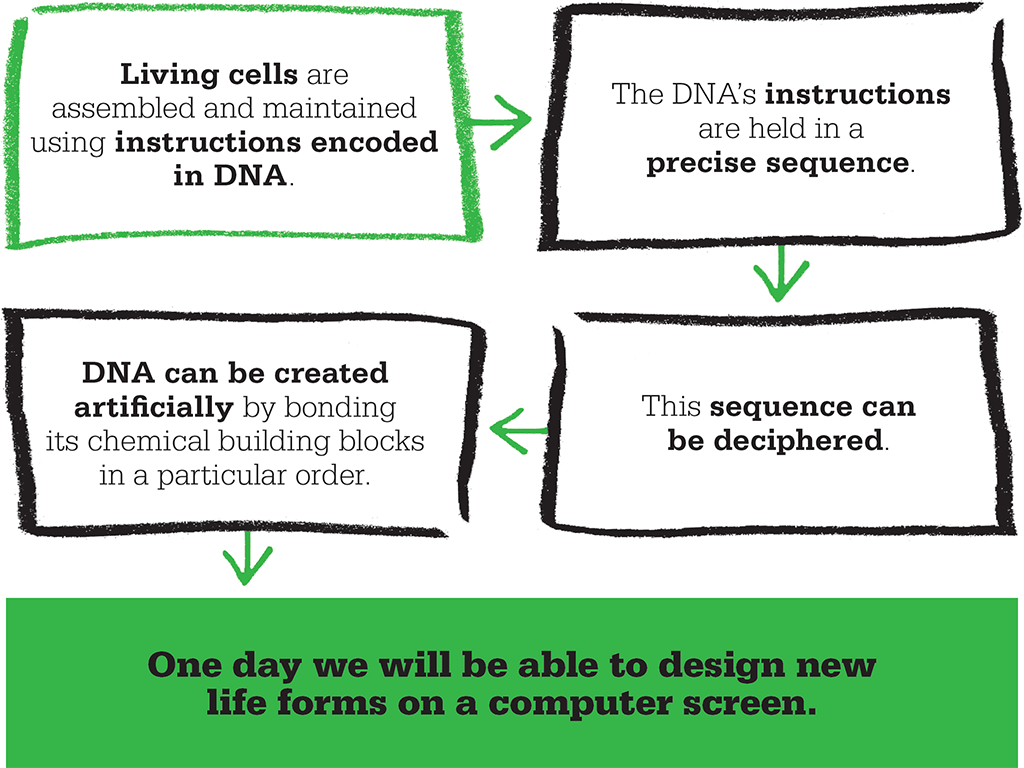
IN CONTEXT
Biology
1866 Gregor Mendel shows that the inherited traits in pea plants follow certain patterns.
1902 American biologist and physician Walter Sutton suggests that chromosomes are the carriers of heredity.
1910–11 Thomas Hunt Morgan proves Sutton’s theory in fruit fly experiments.
1953 Francis Crick and James Watson reveal how DNA carries genetic instructions.
1995 A bacterium’s genome (complete set of genes) is the first to be sequenced.
2000 The human genome is first sequenced.
2007 Craig Venter synthesizes an artificial chromosome.
2010 Venter announces the first synthesis of a life form.
In May 2010, an American team of scientists led by biologist Craig Venter created the first wholly artificial life form. The organism – a single-celled bacterium – was assembled from its raw chemical building blocks. This was a testament to the advance in our understanding of the nature of life itself. The dream of creating life is nothing new. In 1771, Luigi Galvani used electricity to make a dissected frog’s leg twitch, inspiring novelist Mary Shelley to write Frankenstein. But scientists gradually realized that life depends less on a physical “spark” and more on the chemical processes taking place inside cells.
By the mid-1950s, the real secret of life had been found in a molecule called deoxyribonucleic acid, or DNA, which exists in the nucleus of every cell. The long string of DNA’s chemical building blocks was identified as the genetic code that controls the workings of the cell. Creating life would mean creating DNA – and getting the sequence of building blocks, called nucleotides, exactly right. Nucleotides each have one of just four kinds of bases, but combine in countless ways.

"We are creating a new value system for life."
Craig Venter
Making DNA
The sequence of nucleotides differs in each organism, and is the result of millions of years of evolution. A random sequence would send a nonsense chemical “message” that could not maintain a living thing. In order to create life, scientists had to copy a sequence from a naturally existing organism. By 1990, new technology was available to work this out through a host of complex methods, and the international Human Genome Project was launched to sequence the entire human genetic makeup, or genome.
The first organism – a bacterium – was sequenced in 1995. Three years later, frustrated by the slow pace of the Human Genome Project, Venter left to set up the private company Celera Genomics to sequence the human genome more quickly and to release the data into the public domain. In 2007, his team announced that it had made an artificial chromosome – a complete string of DNA – based on that of a bacterium of the genus Mycoplasma. By 2010, his team had inserted an artificial chromosome into another bacterium whose genetic material had been removed, effectively creating a new life form.
Computer-generated life
The genome of even the simplest living thing – such as Mycoplasma – consists of sequences of hundreds of thousands of nucleotides. These nucleotides must be artificially bonded together in a specific order, but doing this for a whole genome is a formidable task. The process is automated with the help of computer technology, on machines that can now decode the genetic blueprint of life, identify genetic factors in disease, and even serve to create new life forms.

Mycoplasma are bacteria that lack a cell wall. They are the smallest known life forms, and were chosen by Venter to be the first organisms to have their chromosomes artificially sequenced.
CRAIG VENTER

Born in Salt Lake City, Utah, USA, Craig Venter performed poorly at school. Drafted into the Vietnam War, he worked in a field hospital and became drawn to biomedical science. After studying at the University of California, San Diego, he joined the US National Institute of Health in 1984. In the 1990s, he helped develop technology that could locate genes in the human genetic makeup, becoming a pioneer in the growing field of genome research. He left the NIH to set up the not-for-profit Institute of Genomic Research in 1992. He invented a way of sequencing whole genomes, focusing first on the bacterium Haemophilus influenzae. Turning to the human genome, he set up the profit-making company Celera and helped build advanced sequencing machines. In 2006, he founded the not-for-profit J Craig Venter Institute to carry out research into the creation of artificial life forms.
Key works
2001 The Sequence of the Human Genome
2007 A Life Decoded